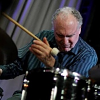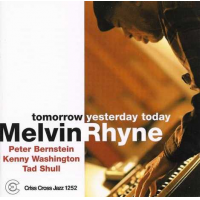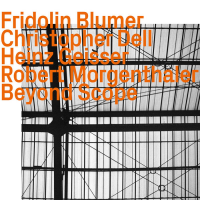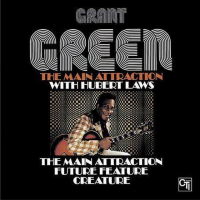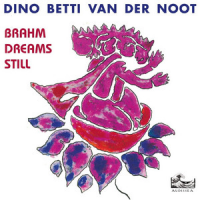Home » Jazz Articles » Liner Notes » Hal Galper Trio: Invitation to Openness
Hal Galper Trio: Invitation to Openness
Marino and Mintz, for their part, have played a significant role in Galper's development of the rubato style of playing, where time gains a sense of elasticity and traditional rhythm section responsibilities are cast aside in favor of equal partnership and simply playing music. The trio was the first stone cast in that direction for the eclectic pianist in 2005-2006, a remarkable late career modernization that ushered in the most significant innovation in the art of the jazz piano trio since Bill Evans' conception of equal partnership with Scott LaFaro and Paul Motian in the early 1960's. The trio was a foray into a more melodic and beauty focused approach to rubato, before the more explosive and aggressive version portrayed by Galper's last touring trio with bassist Jeff Johnson and drummer John Bishop. "I have a certain fondness for this trio. The way the music came out with these guys is really something special to me," says Galper.
For Galper, Marino and Mintz represented the perfect messengers for what he was trying to get at not only in terms of his endless, personal pursuits as a musician, but in the development of that which he had been hearing and envisioning for quite some time conceptually—the freedom of playing jazz with looser parameters in terms of time and musical shape. His approach to playing bebop with master saxophonist Phil Woods in the 1980's bore marks of these revelations, making bassist Marino the perfect foil for his musical ambitions. "Tony was and is a free player in bebopper's clothing, he can cover anything," remarks Galper. He was alerted to Mintz's unique skill set by listening to Johnson's solo recordings on the Seattle based Origin Records label.
Galper's career has been a succession of time spent with jazz masters, followed by periods of personal innovations that have helped blaze the evolutionary path of jazz. In between periods on the road with jazz masters Chet Baker (1965-68), Cannonball Adderly (1973-75) and Phil Woods (1980-1990), Galper left his mark as a bandleader, including historic alliances featuring Randy Brecker and Michael Brecker that both delved into electric fusion and modern, post-bop acoustic jazz. He gained a reputation as a high risk player, who had no fear of taking chances. "I go for the ring, everytime I play. I want to maximize every moment," he says.
Through it all, the ground floor principles of the rubato style began to organically take precedence in his playing. "It had always been part of my playing, because I get bored easily, and when I get bored, I go out. It was just something that was a part of my playing, an element, I never thought about it as a thing in itself. I was the first one to be playing free on tunes," he recalls. His time spent with Sam Rivers in the mid-'60s facilitated this tendency in his playing, as the eclectic reedman like Galper, was a bebop warrior who gravitated towards freer ambitions. It would be some forty years before Galper would manifest those aspects of his playing into tangible form, namely his late career rubato revolution.
After his tenure with Woods in the 1980's, Galper began the 1990's by putting together a trio with drummer Steve Ellington, bassist Todd Coolman and finally west coast bassist Jeff Johnson. The trio probed into his personal revelations honed over thirty years on the road. "I started the trio to work out a couple things I got from Ahmad (Jamal), but mainly the whole idea during those ten years was to try to find my own voice, which I did not," he states flatly. The trio was consistently engaged over the course of the decade, playing what amounts to thousands of dates. He had stumbled upon the rumblings of rubato conceptually while practicing and to this point, never dreamed he could find players to play it with him. Eventually he remembered Marino and chanced upon Mintz. Suddenly, there was a partnership to gather the energy and timelessness of Galper's visionary conception.
"Billy and Tony were my first rubato trio, they helped me develop it," he explains. He had finally exited the road, and come to terms with that which had been his silent partner all those years. "After I broke up the nineties trio, I went back into the shed, really heavy. I needed to get to the next level of technique. That was the first time I found my own voice."
The trio with Marino and Mintz would eventually enter Big Twig Studios to record the album Agents of Change (Fabola, 2006) in April of 2006, utilizing the same cavernous studio space, engineer and microphones used in September of 2008 to record the live performance heard here. As far as the jazz public was concerned, Galper's rubato era had begun, soon to be continued with his west coast trio, and further down the road, his Youngbloods ensemble that passed the rubato baton on to younger, up and coming musicians. No matter which musical partners he chose at a certain time, Galper's revelations were based on a lifetime of music, never forced or coerced by the participants, but allowed to run its natural course. "This was totally unplanned. It came out of itself. What we did was let the music take us. We didn't impose ourselves on the music at all, we just let it take us wherever it would go. It took us to a lot of places," he recalls. This period also saw Galper take a deep dive into the conceptions of John Coltrane, rapidly incorporating what he was learning into his already dynamic playing. The impact on his rubato style was immediate, with the music becoming more aggressive and hard-hitting as he hit the studio with Johnson and Bishop to record the seminal Furious Rubato (Origin, 2007) just two months later in June of 2006. Now more than forty years into his career, Galper was continuing to valiantly move ever forward, inspired by discoveries he made about Coltrane's actual process.
"When I was playing with Jeff (Johnson) and John (Bishop), I was still researching Coltrane. That was influencing my playing a lot at that time. That was influencing the trio and it was quite adventurous. It took ten years for it to flourish. Each time it got better and better. Airegin Revisited (Origin, 2012) was the first time we ever clicked in the zone together," says Galper. He had enabled Coltrane's revolutionary influence by identifying his methodology in practice. "The gold is in your research, 'How did they practice?' That's gold," he surmised. He had figured it out with no way of receiving confirmation. Coltrane had once mentioned in a Swedish interview that when he is not working on anything new, he works on "shapes and patterns." It piqued the pianist's curiosity, realizing, "I knew there was something in there for me."
This indomitable period of innovation for Galper, that so remarkably occurred a half century into his iconic career, was enabled by his trio association with Marino and Mintz, so beautifully portrayed by the tracks contained within. The selected title, Invitation to Openness, aptly describes the vibe of the session. That his weekly performances at Rafter's in 2022 includes these fellow agents of change, is a prime indicator of where Galper resides currently, both physically and emotionally. The rolling hills, wandering waterways and deciduous countryside that surrounds his Sullivan County digs, is emblematic of his emotional connection to a time when he helped change jazz forever. With this historic gem, he places the focus within the constraints of beauty and grace, and takes us to the dawn of innovation.
Liner Notes copyright © 2026 Paul Rauch.
Invitation To Openness can be purchased here.
Contact Paul Rauch at All About Jazz.
I am a writer, producer and coordinator in the jazz community, living in Seattle.
Track Listing
Embraceable You; Rapunzel's Luncheonette; Winter Heart; Ambleside; Invitation to Openness; Take The Coltrane; Wandering Spirit; Constellation.
Personnel
Album information
Title: Invitation To Openness | Year Released: 2022 | Record Label: Origin Records
Tags
PREVIOUS / NEXT
Support All About Jazz
 All About Jazz has been a pillar of jazz since 1995, championing it as an art form and, more importantly, supporting the musicians who make it. Our enduring commitment has made "AAJ" one of the most culturally important websites of its kind, read by hundreds of thousands of fans, musicians and industry figures every month.
All About Jazz has been a pillar of jazz since 1995, championing it as an art form and, more importantly, supporting the musicians who make it. Our enduring commitment has made "AAJ" one of the most culturally important websites of its kind, read by hundreds of thousands of fans, musicians and industry figures every month.




